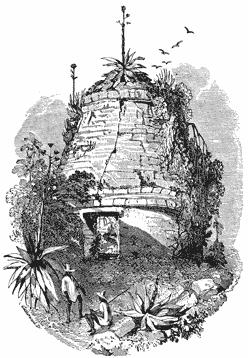One of the World's Leading
Sources of Information On Literature, the Arts, and a Wide Range of
Subjects
Mayapan
(This is taken from John D. Baldwin's Ancient America, originally published in 1871.)

We shall notice only some of the principal ruins in Yucatan, beginning with Mayapan, the ancient capital. The remains of this city are situated about ten leagues, in a southern direction, from Merida. They are spread over an extensive plain, and overgrown by trees and other vegetation. The most prominent object seen by the approaching explorer is a great mound, 60 feet high and 100 feet square at the base. It is an imposing structure, seen through the trees, and is itself overgrown like a wooded hill. Four stairways, in a ruinous condition, 25 feet wide, lead up to an esplanade within 6 feet of the top, which is reached by a smaller stairway. The summit is a plain stone platform 15 feet square. This, of course, was a temple. Sculptured stones are scattered around the base, and within the mound subterranean chambers have been discovered.
It is probable that the principal edifices at Mayapan were not all built wholly of stone, for they have mostly disappeared. Only one remains, a circular stone building 25 feet in diameter, which stands on a pyramidal foundation 35 feet high. On the southwest side of it, on a terrace projecting from the mound, was a double row of columns without capitals, 8 feet apart. There are indications that this city was old, and that the buildings had been more than once renewed. Brasseur de Bourbourg classes some of the foundations at Mayapan with the oldest seen at Palenque and Copan. This point, however, can not be determined with sufficient accuracy to remove all doubt. Mayapan may have stood upon the foundations of a very ancient city which was several times rebuilt, but the city destroyed in 1420 could not have been as old as either Palenque or Copan.
Home | Book Collecting | Folklore / Myth | Philately | Playing Cards | Literature | Contents
